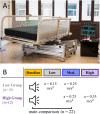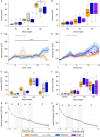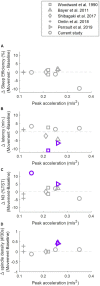Effect of Rocking Movements on Afternoon Sleep
- PMID: 32038144
- PMCID: PMC6985453
- DOI: 10.3389/fnins.2019.01446
Effect of Rocking Movements on Afternoon Sleep
Abstract
Study objectives: Gentle rocking movements provided by a moving bed have been proposed as a promising non-pharmacological way to promote sleep. In rodents the sleep promoting effect of rocking movements depended on the peak acceleration (named "stimulation intensity") perceived by the vestibular system. We set out to verify previous reports on the sleep promoting effect of rocking movements and to investigate the importance of stimulation intensity in this process.
Methods: Side-to-side rocking movements along a pendulum trajectory with different peak accelerations (control: 0 m/s2, low intensity: 0.15 m/s2, medium intensity: 0.25 m/s2, high intensity: 0.35 m/s2) were provided for 45 min during an afternoon nap opportunity. Participants were assigned to a low intensity group (n = 10) experiencing control, low and medium intensity stimulation or a high intensity group (n = 12) experiencing control, medium and high intensity stimulation. Sleep and sleep-related memory performance were assessed using polysomnography and a word-pair memory task, respectively.
Results: Participants transitioned faster into deep sleep under the influence of medium intensity rocking as was evident by a faster buildup of delta power compared to the control condition (n = 22). The faster buildup did not affect sleep architecture, since e.g., the proportion of the nap spent in deep sleep or latencies did not change. Previously reported effects like a shorter latency to stage N2 and a higher density of sleep spindles were not observed. Sleep quality during control naps of the low intensity group was worse than in the high intensity group. In the low intensity group, we also observed a significant increase in delta power throughout the nap, as well as a higher density of slow oscillations both under the influence of low and medium intensity vestibular stimulation. No such effects were observed in the high intensity group.
Conclusion: Rocking movements may promote nap sleep in young adults. Due to a difference in sleep quality during control naps between the low and high intensity group no conclusion regarding the influence of stimulation intensity were possible. Thus, optimal stimulation settings in humans need further investigation.
Keywords: declarative memory; movement Intervention; nap sleep; polysomnography; vestibular stimulation.
Copyright © 2020 van Sluijs, Rondei, Schluep, Jäger, Riener, Achermann and Wilhelm.
Figures





References
-
- Bayer L., Constantinescu I., Perrig S., Vienne J., Vidal P. P., Mühlethaler M., et al. (2011). Rocking synchronizes brain waves during a short nap. Curr. Biol. 21 R461–R462. - PubMed
LinkOut - more resources
Full Text Sources
Research Materials

